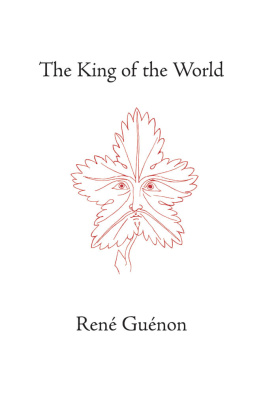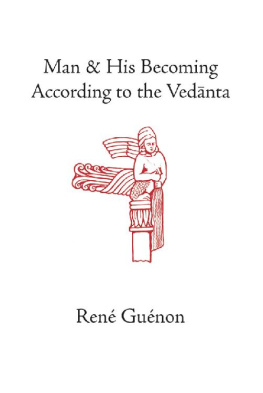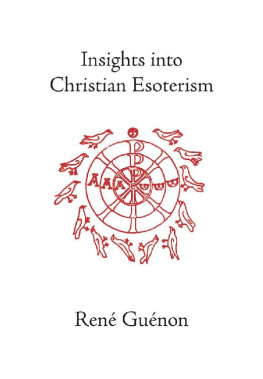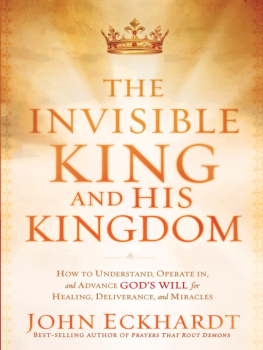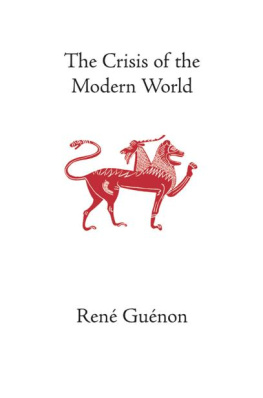COLLECTED WORKS OF REN GUNON
THE KING OF THE WORLD
REN GUNON
THE KING
OF THE WORLD
Translator
Henry D. Fohr
Edited by
Samuel D. Fohr
SOPHIA PERENNIS
HILLSDALE NY
Originally published in
French as Le Roi du Monde
ditions Gallimard 1958
English translation Sophia Perennis 2001
Second Impression 2004
All rights reserved
Series editor: James R. Wetmore
No part of this book may be reproduced or transmitted,
in any form or by any means, without permission
For information, address:
Sophia Perennis, P.O. Box 611
Hillsdale NY 12529
sophiaperennis.com
Library of Congress Cataloging-in-Publication Data
Gunon, Ren
[Roi du monde. English]
The King of the World / Ren Gunon ; translated by
Henry D. Fohr ; edited by Samuel D. Fohr
p. cm. (Collected works of Ren Gunon)
Includes index.
ISBN 0 900588 543 (pbk: alk. paper)
ISBN 0 900588 58 6 (cloth: alk. paper)
1. Kings and rulersMythology. I. Fohr, S.D., 1943
II. Title.
BL325.K5 G813 2001
291.213dc2001000972
THE PUBLISHER
GIVES SPECIAL THANKS TO
HENRY D. AND JENNIE L. FOHR
FOR MAKING THIS EDITION POSSIBLE
CONTENTS
EDITORIAL NOTE
T HE PAST CENTURY HAS WITNESSED an erosion of earlier cultural values as well as a blurring of the distinctive characteristics of the worlds traditional civilizations, giving rise to philosophic and moral relativism, multiculturalism, and dangerous fundamentalist reactions. As early as the 1920s, the French metaphysician Ren Gunon (18861951) had diagnosed these tendencies and presented what he believed to be the only possible reconciliation of the legitimate, although apparently conflicting, demands of outward religious forms, exoterisms, with their essential core, esoterism. His works are characterized by a foundational critique of the modern world coupled with a call for intellectual reform; a renewed examination of meta-physics, the traditional sciences, and symbolism, with special reference to the ultimate unanimity of all spiritual traditions; and finally, a call to the work of spiritual realization. Despite their wide influence, translation of Gunons works into English has so far been piecemeal. The Sophia Perennis edition is intended to fill the urgent need to present them in a more authoritative and systematic form. A complete list of Gunons works, given in the order of their original publication in French, follows this note.
The present book grew out of a conference called by the chief editor of the prestigious journal Les Nouvelles Littraires in 1924 to discuss Ferdinand Ossendowskis then recently published Beasts, Men and Gods . The spokesmen called upon to lead the discussion were the well-known sinologist Ren Grousset, the neo-Thomist philosopher Jacques Maritain, and Ren Gunon, who was invited as an expert in Hinduism. Beasts, Men and Gods is a thrilling account of an escape through Central Asia, in which the author faces great hardships, meets and foils various enemies, and then comes into contact first with shamans, and then with Mongolian lamas, whose marvels he describes. The book caused a great sensation, especially the final chapters, in which Ossendowski recounts legends allegedly passed on to him concerning the King of the World and of his subterranean kingdom of Agarttha. Three years after this conference, Gunon published the present text, in which he develops the theme of the King of the World from the point of view of traditional metaphysics.
Gunon often uses words or expressions set off in scare quotes. To avoid clutter, single quotation marks have been used throughout. As for transliterations, Gunon was more concerned with phonetic fidelity than academic usage. The system adopted here reflects the views of scholars familiar both with the languages and Gunons writings. Brackets indicate editorial insertions, or, within citations, Gunons additions. Wherever possible, references have been updated, and English editions substituted.
A translation of this work under the title The Lord of the World was published by Coombe Springs Press in 1983. The present translation is based on the work of Henry Fohr, edited by his son Samuel Fohr. The entire text was checked for accuracy and further revised by Marie Hansen. Editorial contributions were also made by John Champoux, John Ahmed Herlihy, William Quinn, and Mark Mancuso. A special debt of thanks is owed to Cecil Bethell, who revised and proofread the text at several stages and provided the index. Cover design by Michael Buchino and Gray Henry, based on a drawing of the Green Man, known to Islam as al-Khidr, by Gunons friend and collaborator Ananda K. Coomaraswamy.
THE WORKS
OF REN GUNON
Introduction to the Study of the Hindu Doctrines (1921)
Theosophy: History of a Pseudo-Religion (1921)
The Spiritist Fallacy (1923)
East and West (1924)
Man and His Becoming according to the Vednta (1925)
The Esoterism of Dante (1925)
The Crisis of the Modern World (1927)
The King of the World (1927)
Spiritual Authority and Temporal Power (1929)
The Symbolism of the Cross (1931)
The Multiple States of the Being (1932)
The Reign of Quantity and the Signs of the Times (1945)
Perspectives on Initiation (1946)
The Great Triad (1946)
The Metaphysical Principles of the Infinitesimal Calculus (1946)
Initiation and Spiritual Realization (1952)
Insights into Christian Esoterism (1954)
Symbols of Sacred Science (1962)
Studies in Freemasonry and the Compagnonnage (1964)
Studies in Hinduism (1966)
Traditional Forms and Cosmic Cycles (1970)
Insights into Islamic Esoterism and Taoism (1973)
Reviews (1973)
Miscellanea (1976)
WESTERN IDEAS ABOUT AGARTTHA
S AINT- Y VES D A LVEYDRES posthumous work Mission de lInde , first published in 1910, However, in 1924 a book entitled Beasts, Men and Gods appeared unexpectedly on the scene, in which the author, Ferdinand Ossendowski, relates the incidents of a most eventful journey he made across Central Asia in the years 1920 and 1921, including, especially in its latter part, accounts almost identical with those given by Saint-Yves; and we believe that the sensation aroused by this book at last furnishes a favorable opportunity to break the silence on the question of Agarttha.
Naturally, hostile and sceptical critics did not fail to accuse Ossendowski of simply plagiarizing Saint-Yves, supporting their allegation by pointing out all the concordant passages in the two books; and in fact there are a good number that show a rather astonishing similarity, even to points of detail. First of all, in one of his most improbable passages, Saint-Yves asserts the existence of a subterranean world with branches everywhereunder continents and even under the oceansby means of which communications are invisibly established between all the regions of the earth; more-over, Ossendowski does not affirm this on his own authority, even declaring that he does not know what to think of it, but attributes it rather to reports received from people he met in the course of his journey. On a more particular point, there is also a passage in which the King of the World is depicted in front of his predecessors tomb and where the question is raised concerning the origin of the gypsies, But most important of all, by a strange coincidence both writers tell the story of an island now vanished where extraordinary men and beasts once lived; at this point Saint-Yves cites the summary by Diodorus of Sicily of the journey of Iambulus, whereas Ossendowski describes the journey of an ancient Buddhist from Nepal; but their accounts hardly differ, so that if two versions from such widely divergent sources really do exist it would be interesting to acquire them and compare them carefully.

